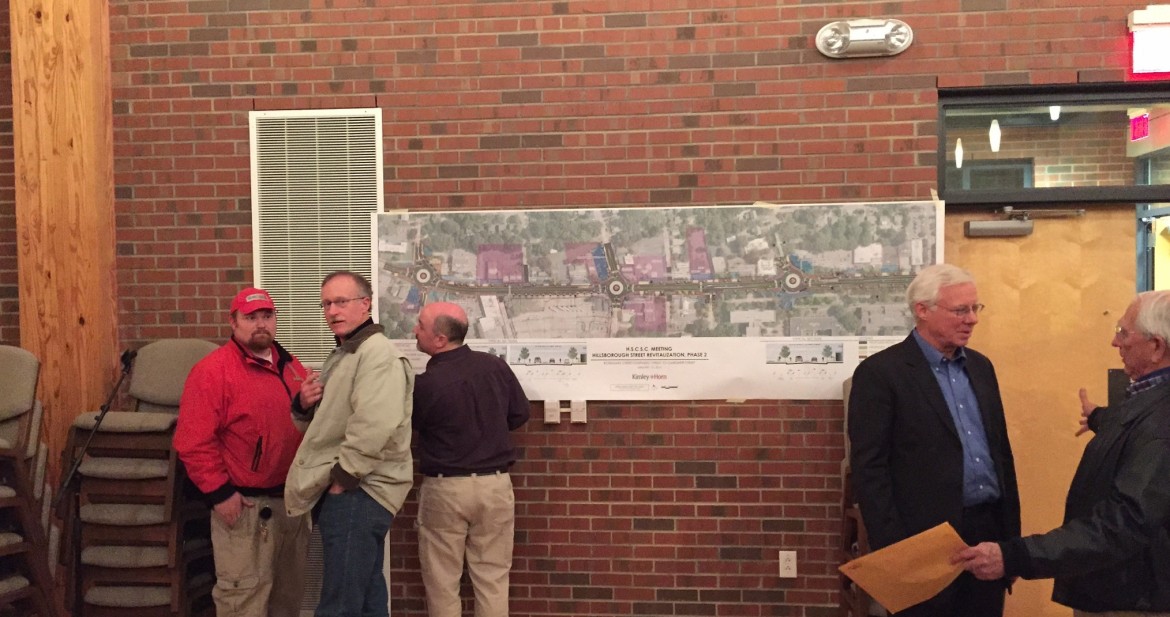Editor’s note: the crash data included here was originally attributed to Kimley-Horn. It was actually compiled by Raleigh’s Office of Transportation Planning.
A crowd of around 25 concerned business and property owners convened last week to discuss the potential impacts of the second phase of the Hillsborough Street Redevelopment project.
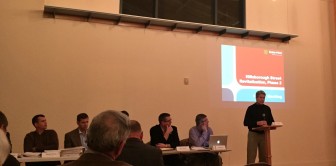
James Borden / Raleigh Public Record
Dan Howe addresses a crowd of around 25 business and property owners.
The public forum was held in the Pullen Baptist Church and moderated by Dan Howe, president of the Hillsborough Community Services Corporation. A panel of experts from both the city and the engineering firm handling the redesign, Kimley-Horn, was on hand to address the questions and concerns of those in attendance.
Charles Grantham, an owner of 3116 and 3126 Hillsborough, expressed grave concerns over the plan to remove the left-turn lane, which will free up room for bike lanes and a median.
“This plan is going to kill traffic on Hillsborough Street; the left turn lane is an important ingredient of traffic, it’s a pop-off valve that allows all the mini conundrums that occur on street to keep moving,” Grantham said.
“Removing that is going to back up traffic.”
Grantham also asked whether an economic study had been done to study the potential impact of the left-turn lane removal on existing merchants.
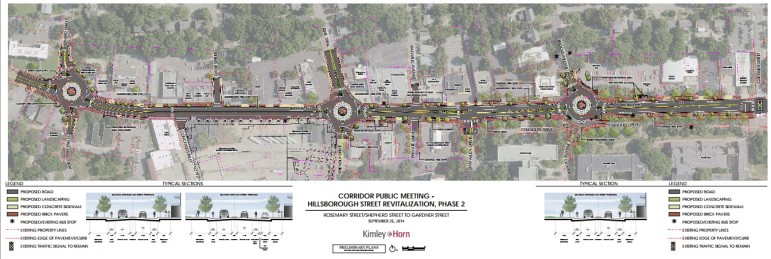
City of Raleigh
A map of the second phase of the Hillsborough Street Redevelopment Project
“We’ve had a Pizza Hut in [3116 Hillsborough] for 25 years — they’re leaving, we had a shop that sold vintage clothes, they just left, and they’re having, as many on Hillsborough are, a difficult time trying to derive revenue from just students,” Grantham said.
“Our experience has been that businesses can’t make a good living if you restrict the traffic flow that supplants the student expenditures, unless you want to wind up with a bunch of funny cigarette shops and tattoo parlors,” he said.
Improving the Flow of Traffic
Jeff Moore, an engineer with Kimley-Horn, said there had been an economic impact study done for phase I, but not phase II. He noted, however, that the removal of the left-turn lane would not be detrimental to existing businesses.
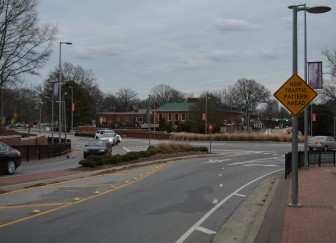
James Borden / Raleigh Public Record
An existing roundabout on Hillsborough Street
“The roundabouts would facilitate left turns by having people do U-turns,” Moore said, adding that most consumers would not be deterred by such a requirement.
The roundabouts would also quicken the flow of traffic on Hillsborough by removing traffic lights, Moore’s colleague Jason Pace explained.
“When you design a [traffic] signal you have to have it timed enough for a pedestrian to cross that road; there’s a lot less queues at a roundabout than a signal.”
Ted Van Dyk, a principal at New City Design Group, located at 1304 Hillsborough, said that speeding up traffic flow should not be the primary concern.
“If you want a vibrant street, what we’re hearing is the perception that you’re going down a street you can’t make a turn into a business, you’re going to go somewhere else. You guys are comfortable with the idea of taking U-turns and turning around and coming back – I don’t think that’s a real strong sell for folks,” Van Dyk said.
“The idea that the street is going to be a series of U-turns and backups and go-rounds and come-arounds and turnarounds; I think this is where the question of the economic component comes in — it’s not really a traffic question, if we want traffic to move down Hillsborough faster, we can.”
Public Safety
Grantham argued that in addition to the potential negative economic impact, removal of the middle lane would also make it more difficult for emergency responders to travel down the street.
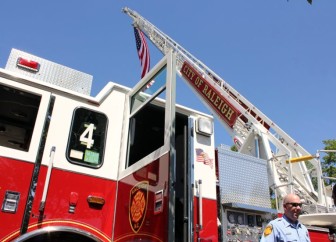
A ladder truck
“Our building caught on fire 20 years ago, had a fire truck not gotten there as quick as it did, the entire building would have burned down,” Grantham said.
“I asked [the Raleigh Fire Department] what they thought of this, and they said “We hate it, Chuck.”
Lamb said there would be enough width on the street to allow motorists to pull into the bike lane should they need to make way for an emergency vehicle, adding that the fire department always prefers to err on the side of larger roads.
“I work with the fire department on a lot of things, and they tend to hate everything. If firemen ruled the world, every street would be 50 feet wide.”
Emergency response was not the only safety issue raised by the project.
A study of bicycle crashes in the city from 2000-2006 showed that Hillsborough had the most, at 26. The next highest was New Bern Avenue with 16.
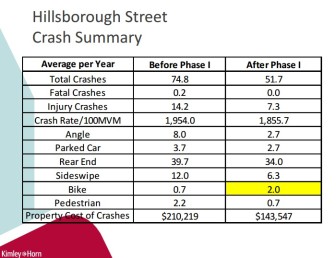
Kimley-Horn
Accident data from before and after phase I of the Hillsborough Street Development project
A study conducted by the city’s Office of Transportation Planning following the implementation of phase I of the Hillsborough Street Redevelopment showed that accidents in every category but one had declined. Before phase I, there had been an average of .7 bicycle accidents per year; after phase I, that number more than doubled, to 2.
Lamb said this was likely due, in part, to the increased popularity of biking throughout the city, particularly on Hillsborough Street.
“I know, anecdotally, cycling is up significantly in that corridor,” he said.
“We’ve got more people cycling on the street, and we’re lucky that none [of the crashes] have been very severe.”
Breaking Ground
Lamb said construction work on phase II, which will cost the city a total of $12.9 million, will likely begin in the spring of 2015 and last anywhere from 15-18 months.
“Right in the beginning we’re going to be doing the utilities, digging huge trenches. We would love to be able to do most of that work in the summer before the students come back, like we did in phase I.
“It worked pretty well last time.”
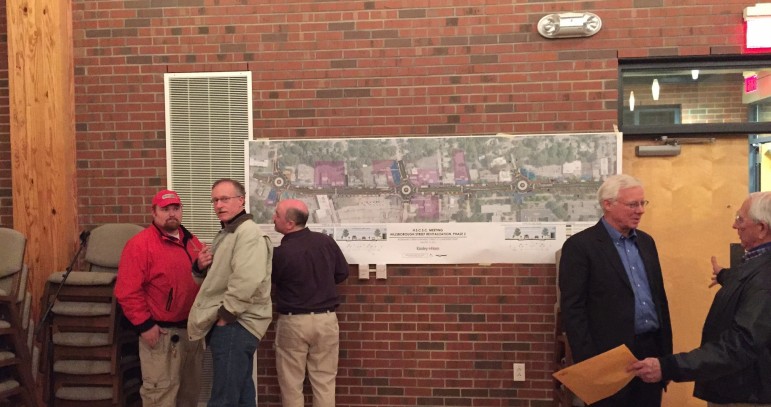
James Borden / Raleigh Public Record
Councilor Russ Stephenson was in attendance at the public forum. Also present but not pictured was councilor Kay Crowder.
